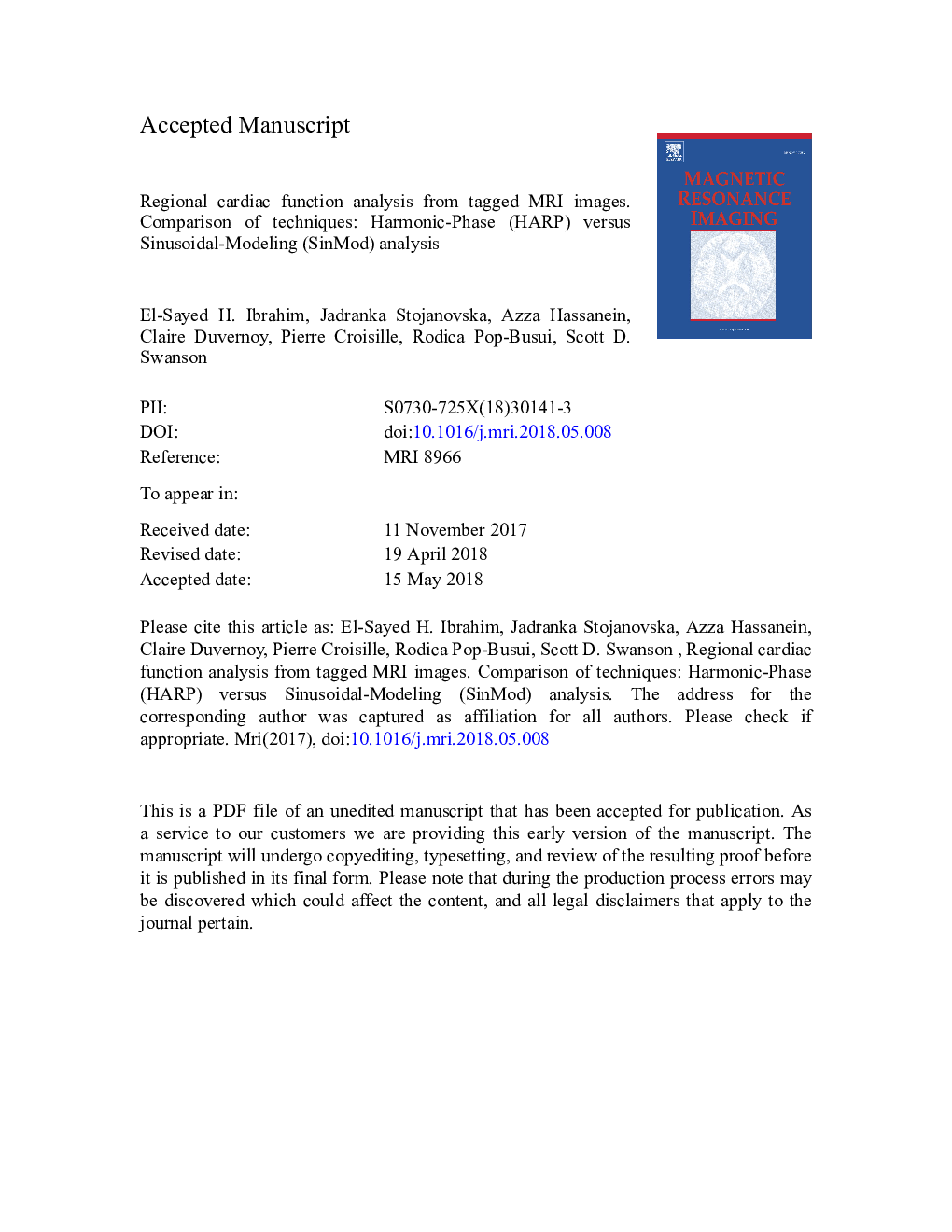| کد مقاله | کد نشریه | سال انتشار | مقاله انگلیسی | نسخه تمام متن |
|---|---|---|---|---|
| 11007521 | 1524989 | 2018 | 44 صفحه PDF | دانلود رایگان |
عنوان انگلیسی مقاله ISI
Regional cardiac function analysis from tagged MRI images. Comparison of techniques: Harmonic-Phase (HARP) versus Sinusoidal-Modeling (SinMod) analysis
دانلود مقاله + سفارش ترجمه
دانلود مقاله ISI انگلیسی
رایگان برای ایرانیان
موضوعات مرتبط
مهندسی و علوم پایه
فیزیک و نجوم
فیزیک ماده چگال
پیش نمایش صفحه اول مقاله

چکیده انگلیسی
Cardiac MRI tagging is a valuable technique for evaluating regional heart function. Currently, there are a number of different techniques for analyzing the tagged images. Specifically, k-space-based analysis techniques showed to be much faster than image-based techniques, where harmonic-phase (HARP) and sine-wave modeling (SinMod) stand as two famous techniques of the former group, which are frequently used in clinical studies. In this study, we compared HARP and SinMod and studied inter-observer variability between the two techniques for evaluating myocardial strain and apical-to-base torsion in numerical phantom, nine healthy controls, and thirty diabetic patients. Based on the ground-truth numerical phantom measurements (strainâ¯=â¯â20% and rotation angleâ¯=â¯â4.4°), HARP and SinMod resulted in overestimation (in absolute value terms) of strain by 1% and 5% (strain values), and of rotation angle by 0.4° and 2.0°, respectively. For the in-vivo results, global strain and torsion ranges were â10.6% to â35.3% and 1.8°/cm to 12.7°/cm in patients, and â17.8% to â32.7% and 1.8°/cm to 12.3°/cm in volunteers. On average, SinMod overestimated strain measurements by 5.7% and 5.9% (strain values) in the patients and volunteers, respectively, compared to HARP, and overestimated torsion measurements by 2.9°/cm and 2.5°/cm in the patients and volunteers, respectively, compared to HARP. Location-wise, the ranges for basal, mid-ventricular, and apical strain in patients (volunteers) were â8.4% to â31.5% (â11.6% to â33.3%), â6.3% to â37.2% (â17.8% to â33.3%), and â5.2% to â38.4% (â20.0% to â33.2%), respectively. SinMod overestimated strain in the basal, mid-ventricular, and apical slices by 4.7% (5.7%), 5.9% (5.5%), and 8.9% (6.8%), respectively, compared to HARP in the patients (volunteers). Nevertheless, there existed good correlation between the HARP and SinMod measurements. Finally, there were no significant strain or torsion measurement differences between patients and volunteers. There existed good inter-observer agreement, as all measurement differences lied within the Bland-Altmanâ¯Â±â¯2 standard-deviation (SD) difference limits. In conclusion, despite the consistency of the results by either HARP or SinMod and acceptable agreement of the generated strain and torsion patterns by both techniques, SinMod systematically overestimated the measurements compared to HARP. Under current operating conditions, the measurements from HARP and SinMod cannot be used interchangeably.
ناشر
Database: Elsevier - ScienceDirect (ساینس دایرکت)
Journal: Magnetic Resonance Imaging - Volume 54, December 2018, Pages 271-282
Journal: Magnetic Resonance Imaging - Volume 54, December 2018, Pages 271-282
نویسندگان
El-Sayed H. Ibrahim, Jadranka Stojanovska, Azza Hassanein, Claire Duvernoy, Pierre Croisille, Rodica Pop-Busui, Scott D. Swanson,